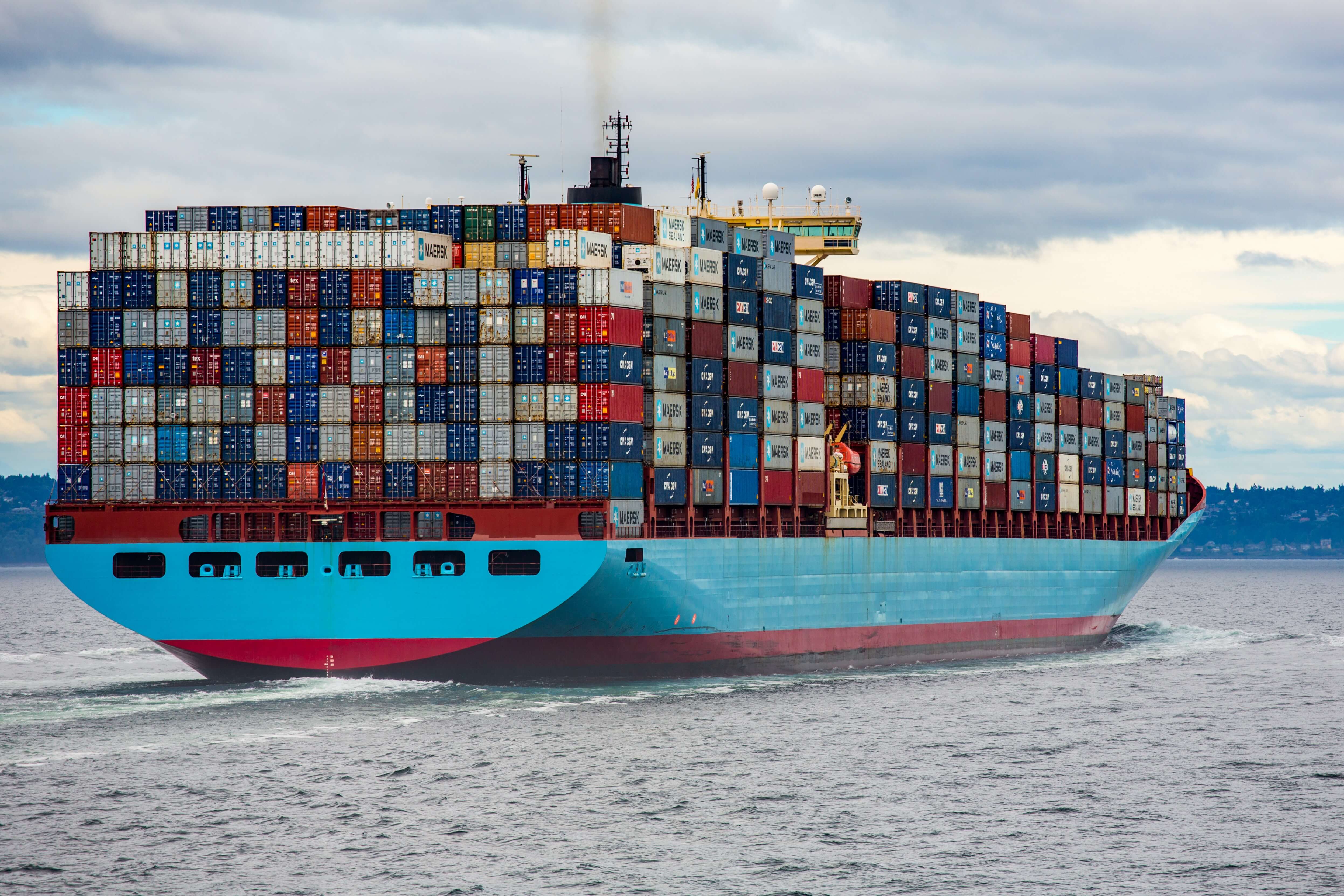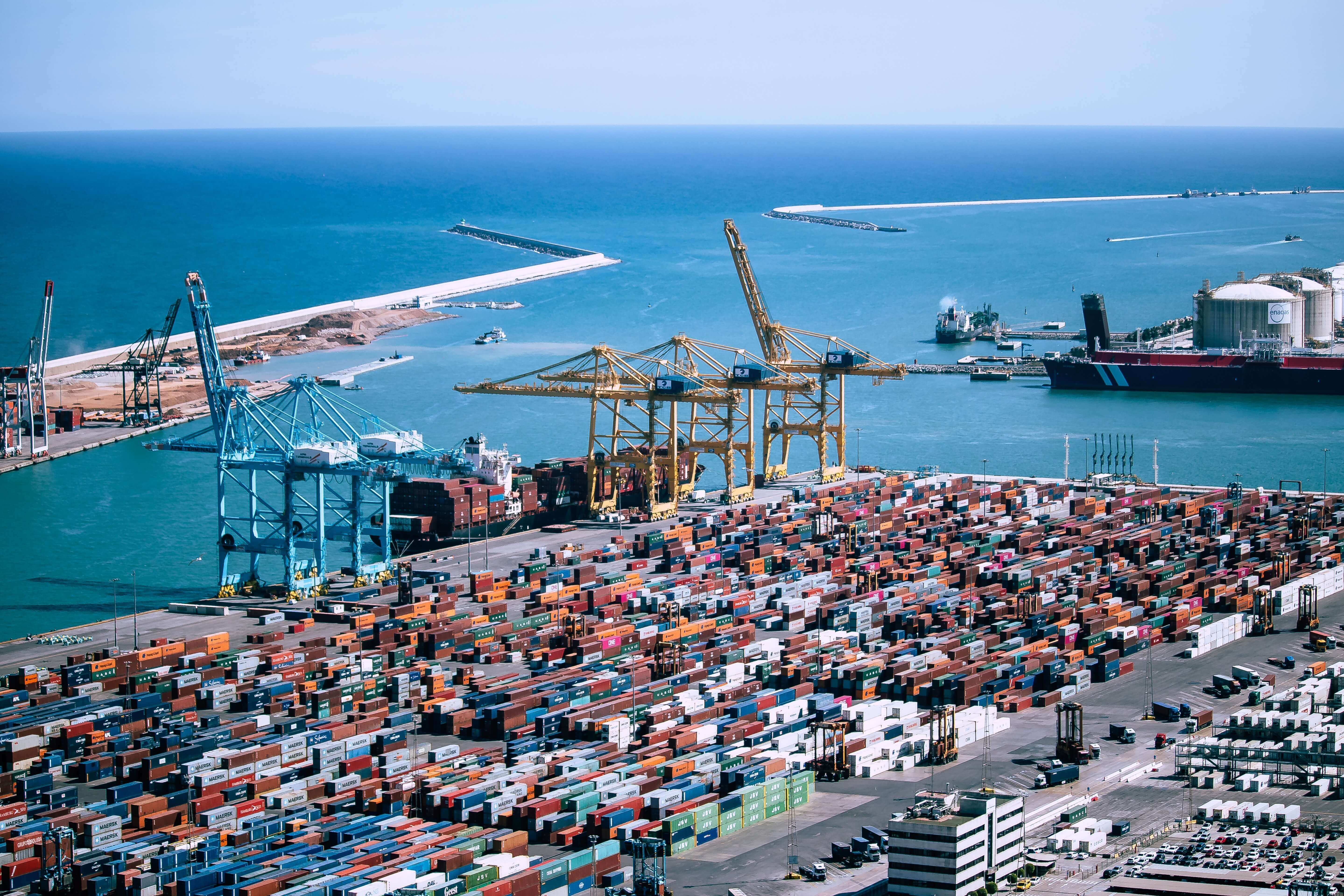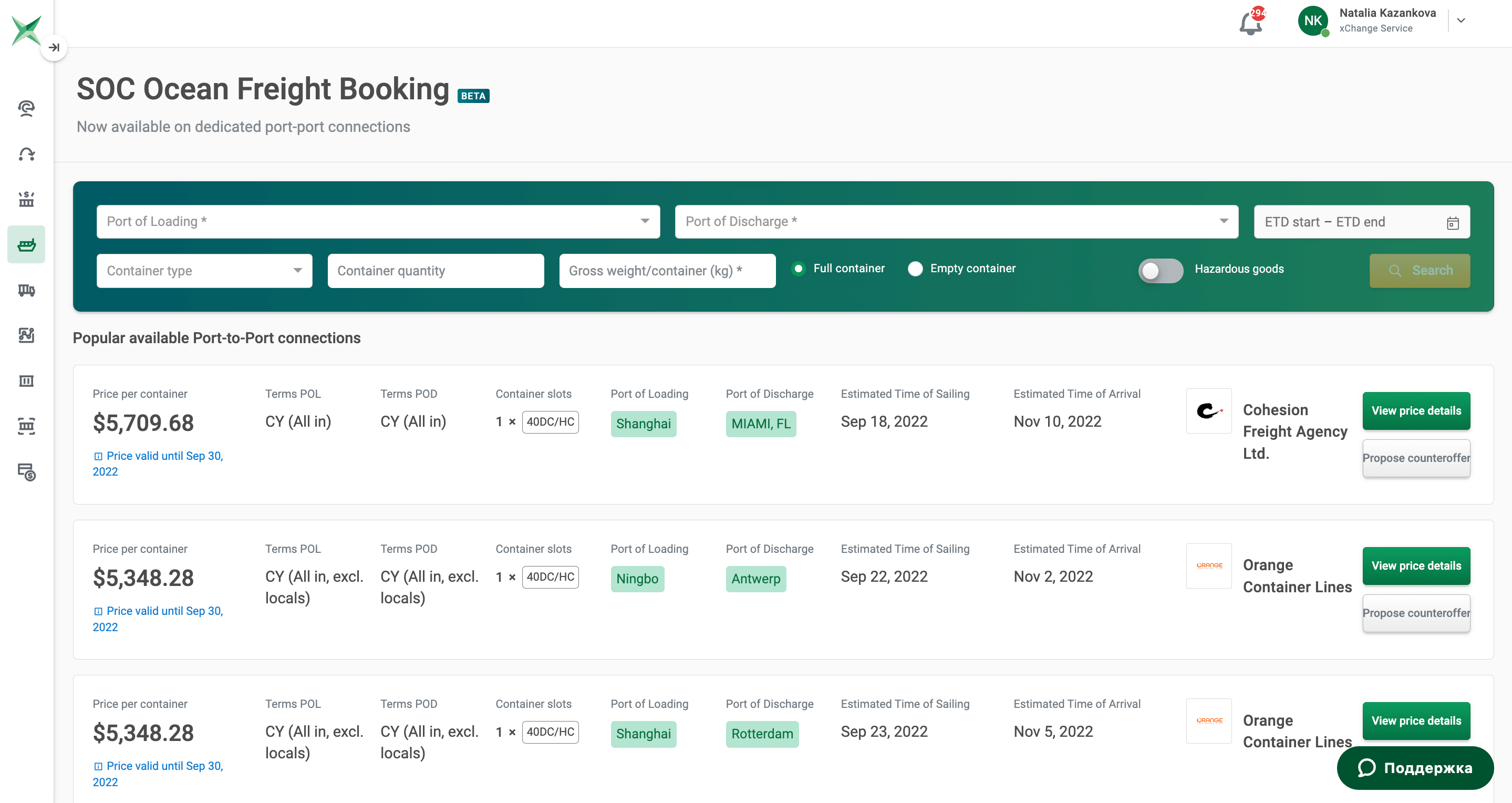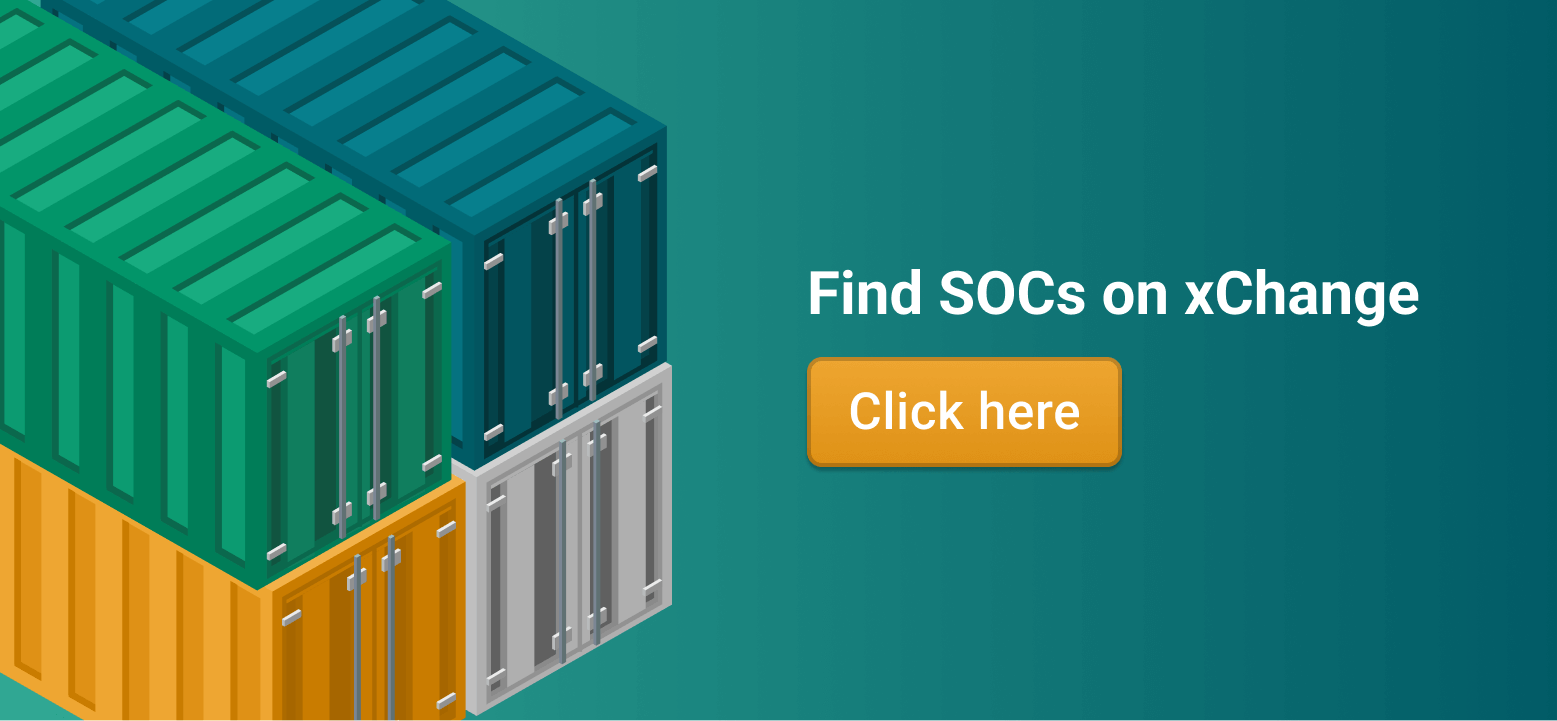If you want to know all about container shipments and how the shipping process works, you’ve arrived at the perfect blog. Find out everything you need to know about container shipping here. Plus, secure vessel slots for SOCs, view shipping schedules, and make safe payments on our Ocean Freight Marketplace. Want to skip the blog and learn about the Ocean Freight Marketplace directly? Talk to our experts now.
Container shipping is the backbone of world trade, with around 90% of all goods being transported by sea. In 2020, around 1.85 billion metric tons of cargo were shipped worldwide, up from just 0.1 billion in 1980.
The industry is always growing and evolving. However, with consumerism constantly on the rise, the shipping world has struggled to keep up, and it can be difficult to secure boxes, get slots on vessels and access shipping schedules when you need them. With these growing demands, freight rates have also shot sky high.
Want to learn more about the current pain points associated with ocean freight booking? Read our survey of 137 companies around the world, by clicking here.
Luckily, at Container xChange, we have the solution you’ve been looking for.
We’re a container marketplace where you can lease and trade boxes in over 2,500 locations worldwide. We offer the only online Ocean Freight Platform for shipper owned containers (SOCs). Booking slots on vessels (even at short notice), viewing schedules and comparing freight rates has never been easier!
Become a member on Container xChange to start finding great deals on SOCs, and use our Ocean Freight Marketplace at no extra cost. Click below to book a platform demo today, and simplify your container logistics once and for all.
What are container shipments?
Container shipments include any cargo transported in shipping containers along fixed routes. A shipping container may travel on multiple modes of transport, including trucks, trains and ships, before arriving at its final destination.
There are two kinds of container shipments: FCL (full container load), and LCLWhat is less than container load? Less than container load (less than container load, LCL) is a shipping term that refers to the delivery of cargo in smaller quantities than a full container load. A f... More (less than full container load).
| FCL | If you have enough goods to fill an entire container, your load is referred to as a ‘full container load’. FCLs work out cheaper per unit than LCLs, and importing fees are fixed. FLCs are also the most secure, as only your items are packed into the container, so other shippers’ cargo can’t contaminate or damage yours. |
| LCL | If you’re only looking to ship small quantities of goods, it’s more economical to share a box with other shippers, rather than using a whole container for yourself. LCLWhat is less than container load? Less than container load (less than container load, LCL) is a shipping term that refers to the delivery of cargo in smaller quantities than a full container load. A f... More is more expensive per unit, but cheaper overall, as volumes are lower than with FCLs. |
Need help calculating container loading? Check out this blog post for a step-by-step guide.
Depending on the type of cargo you’re shipping, you’ll need a specific container type for your goods. We’ll go over some of the most commonly used container types in the next section.
Container shipments: Sizes and types
Shipping containers are so much more than steel boxes. They’re the building blocks of global trade. Almost all of the goods we consume now days arrive in a shipping container of some kind. Therefore, it’s of utmost importance that they are strong and sturdy, reliable and completely standardized.
For a shipping container to be allowed onboard a ship, it needs to meet the standard requirements, regulated by ISO (International Organization for Standardization).
ISO standards require that all cargo containers are built to withstand extreme weather conditions, and have strong structural integrity (many fully-loaded boxes need to be able to be stacked on top of one another safely). They also have to adhere to certain standard measurements.
Shipping containers also need to be intermodal. Intermodal containers are boxes that can be used across multiple transport modes, including trains, trucks and ships.
Now let’s take a look at some of the most commonly-used container types for shipping.
Standard dry shipping containers
Standard dry containers can be used to transport dry goods, including grains, clothing, electronics, pallets, barrels, and more. They come in these main sizes: 20ft and 40ft standard containers, and 20ft, 40ft and 45ft high cube shipping containers.
Take a look at the measurements for the 3 standard sizes:
| Size | 20ft | 40ft | 40ft HC |
| Internal length | 5.9m / 19.4ft | 12.03m / 39.5ft | 12.03m / 39.5ft |
| Internal width | 2.35m / 7.8ft | 2.4m / 7.9ft | 2.35m / 7.8ft |
| Height | 2.39m / 7.9ft | 2.39m / 7.9ft | 2.70m / 8.10ft |
| Cubic capacity | 1,172 cu ft / 33.2 cu m | 2,389 cu ft / 67,7 cu m | 2,694.5 cu ft / 76.3 cu m |
| Payload capacity | 55,126.9 lbs / 25,000 kg | 61,200 lbs / 27,600 kg | 63,052 lbs / 28,000 kg |
| Tare weight | 5,071.5 lbs / 2,300 kg | 8,268.8 lbs / 3,750 kg | 8,598 lbs / 3,900 kg |
Whilst standard boxes are great for transporting dry goods of all kinds, you’ll need a special box if you’re moving temperature-sensitive items, extra-large, or oddly-shaped goods that won’t fit into a normal container.
Reefer shipping container
A reefer is a refrigerated box, with specialized cooling equipment. This container type is used to transport temperature-sensitive goods like dairy products, medicine, meat and fruits.
Flat rack shipping container
The flat rack is a special container designed to transport oddly-shaped or oversized cargo. It’s easy to load items onto a flat rack due to its lack of walls. Lashing rings secure the cargo once loaded, preventing it from moving or slipping.
Pallet-wide shipping container
Pallet-wide containers are designed to transport pallets. Standard pallet-wide boxes can carry 2 euro-pallets stacked side by side, and piled to the top.
Double door shipping container
A double door container has doors on both ends. This allows for easy loading and unloading of goods. Cars and motorbikes can simply be driven in one end, and out of the other. Convenient!
How does container shipping work?
Container shipping is an extremely complex process, involving many players, and lots of moving parts. It all begins with an order. Usually, a client will order goods from a manufacturer, and work with a freight forwarding service to get the goods shipped to them.
Most of the time, shipping containers are needed, as well as multiple modes of transport, depending on where the factory is, in comparison with the final destination. In most cases, the freight forwarder will be in charge of finding the most efficient, and cost effective route from point A to point B, taking care of everything in-between.
Here’s a flowchart of the shipping process, so you can see how it works from the time the cargo is loaded into the box, until the time the empty container arrives at the shipping yard to await it’s next trip:
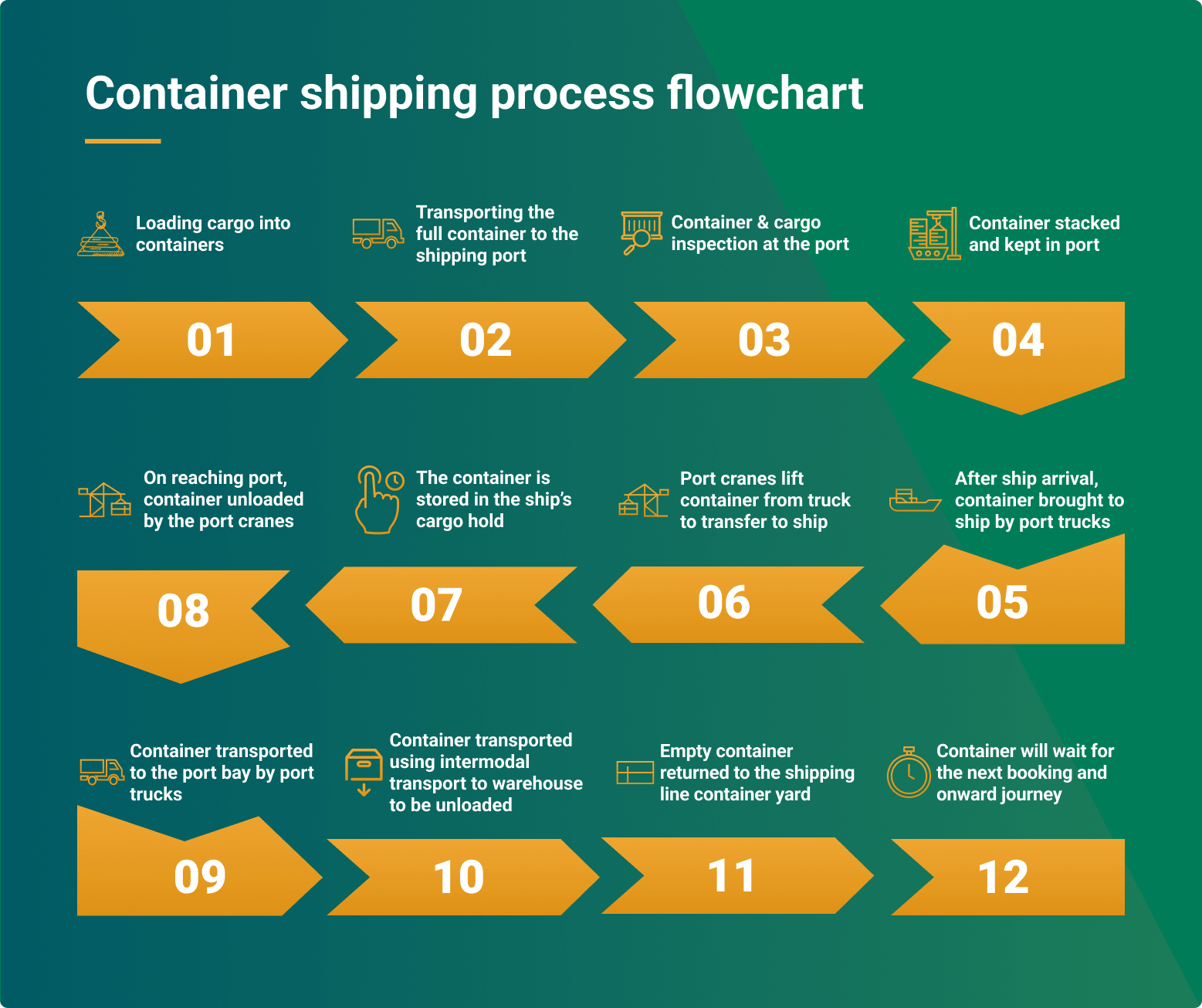
A closer look at the container shipment process:
1. The exporter selects containers from a shipping company.
2. The freight forwarder arranges transport for the containers to the exporter for filling, stuffing, and sealing of cargo.
3. The freight forwarder arranges transport for the containers from the exporter’s factory to the designated shipping port for loading onto the ship.
4. After port paperwork, customs checks, and final inspection, the container is moved inside the port storage facility.
5. In the port, the container is measured and this data is recorded. The container is then stacked, ready to be loaded on the ship.
6. Once the ship arrives, the container is brought to the ship by port trucks.
7. Port cranes are used to lift the container from the truck onto the ship.
8. The container is stored in the ship’s cargo hold.
9. Once the ship reaches the destined port, the container is unloaded by port cranes and transported to the port bay by port container trucks.
10. After custody of the shipment is acquired by the freight forwarder, the container is transported using intermodal transport to the importer’s warehouse, where the container is unloaded.
11. The empty container is returned to the shipping line’s designated container yard, where it awaits its next booking.
Interested in leaning about the pain points in current ocean freight booking? Check out this survey of 137 companies around the world to access the full report.
Now that you’ve seen the shipping process, it’s time to learn everything you need to know about preparing a shipment. Keep reading to get all the best tips.
Preparing for container shipment
So, what do you need to do to make sure your cargo is ready for shipping? Keep in mind the following:
Packaging: Make sure that your packaging is lightweight, and doesn’t add too much bulk to your overall container load, as this will make your shipment more expensive. Packaging your cargo with quality materials, and in the correct way will ensure that your shipment is protected from damage.
How a container is packed is also of vital importance. Make sure that items are packed tightly, with heavier cargo at the bottom. Also check that the weight is evenly distributed throughout the box, in order to prevent it from toppling off a truck or ship!
Container seals: Always have a good quality container seal on your box. Otherwise, you run the risk of your container being tampered with, which could lead to goods being stolen or damaged. A good container seal is also essential in order to pass customs, and you won’t be able to insure your boxes without one.
CSC plate: A CSC plate is a safety approval plate, and no container will be allowed onboard a ship without one. To get a valid CSC plate, the containers you’re using must have passed a safety inspection.
The good news? Container xChange members can request CSC inspections and other surveys through the platform. Check out this blog piece for more information on this.
Transporting your shipment container
How will you get your cargo from the warehouse to the port? You’ll have to hire a trucking service for this. There are different types of trucks suited to different sizes and types of containers. For example, the tilt-bed truck is perfect for lighter cargo, whereas the HIAB truck is used for large, heavy containers and loads.
Check out some of the different container movers in this informative blog post.
Depending on the route, your boxes may also have to travel via rail, as there are some areas where trucks may not be able to pass. For longer journeys, rail works out cheaper than trucking, so keep this in mind when booking transport for your containers.
Container shipment tracking
Containers make very long journeys from their starting point to their final destination. This often includes trips on trucks, trains and ships. Along the way, various things can go wrong which can delay shipments.
It’s good to keep track of your boxes, so that you can preempt any issues or delays, and make alternative arrangements for your clients when issues arise. As we all know, delays cost money, and lead to unhappy customers.
Once you’re a member of Container xChange, you’ll be able to track your containers easily from the comfort of your office. Say goodbye to spending ages on the phone, trying to locate containers, or struggling with shipping line websites.
With our tracking software, you’ll be able to check where your containers are at any time. Plus, you can see which boxes are on time, and which are delayed, all on one convenient dashboard. You can also keep track of where they are, in case your customers want to know.
![]()
Learn more about container tracking with xChange here.
Documents needed for customs clearance
Customs clearance is important in order for your boxes to be allowed onboard a vessel. If your boxes don’t get clearance, you could be liable for fines, not to mention the delay in delivering the cargo.
There are a few important documents you’ll need to have in order to pass through customs successfully. These include the bill of lading, which is essentially the shipping contract. Goods can’t be handed over if the receiver doesn’t have this document.
Another important document is the bill of freight. This is the invoice for the cost of shipping the goods from A to B. Other documents include the commercial invoice, the certificate of origin, the buyer’s purchase order and the packing list. See the full list of documents here.
As a member of Container xChange, you can get all of these important documents digitized. So you’ll no longer have to worry about keeping them safe, or waiting for them to arrive on time.
Want to digitize your shipping documentsWhat are shipping documents? In shipping, shipping documents are documents that provide information about the goods being shipped. They may include information such as the origin and destination of th... More and access them safely in one convenient place? Click below to sign up for a demo of our platform.
How much do container shipments cost?
The cost of container shipments varies considerably, and depends on factors including the container type, the stretch and the current market situation.
For many shippers, leasing containers for one-way moves makes the most sense. One-way leasing involves leasing a box for a single stretch only, and is much more cost efficient than buying boxes, especially in the short term. It also gives you more free days (you’ll pay very little in per diem charges), and means you can avoid empty container repositioning.
In fact, there are some stretches where the container owner pays you to move their boxes. Now that’s a win-win situation!
On Container xChange, you can access SOCs (shipper owned containers) for one-way leasing at competitive rates.
The pick up rate is the one-time charge for a container that’s picked up. Let’s take a look at some pick up rates for popular stretches:
20ft shipping container average pickup rates
- Shanghai to Houston: US $ 800
- Qingdao to New York: US $ 600
- Ningbo to Liverpool: US $ 245
- Antwerp to Nhava Shiva: US $ 50
40ft shipping container average pick up rates
- Shanghai to Houston: US $ 2,600
- Duisburg to Qingdao: US $ 602
- Ningbo to Liverpool: US $ 3,475
- Antwerp to Shanghai: US $ 112
Interested in securing SOCs to increase the reliability and flexibility of your container operations? Simply type in the container type you’re after, and the location, and press ‘search’ to get started:
Two types of freight container shipping
There are two ways of shipping freight, you can either use: COCs (carrier-owned containers) or SOCs (shipper-owned containers). Each has advantages and disadvantages. Let’s look at some of the differences below:
COC freight shipping
Using COCs means that you use boxes owned by a carrier or logistics company. In this case, you can book a complete package with the shipping line, and everything is organized for you. It sounds simple enough. The catch? You’ll be liable for demurrage and detention fees if there are any delays or issues along the way.
SOC freight shipping
With SOCs, you basically ‘bring your own box’ and just book a slot on the vessel. SOCs are usually owned by individuals or business owners. A container is considered a SOC when the Beneficial Cargo Owner (BCO), freight forwarder, or NVOCC organizes its own box.
Buy Shipper Owned Containers (SOCs)
For businesses looking to gain more control over their logistics, purchasing Shipper Owned Containers (SOCs) is a strategic move. SOCs allow shippers to own their containers, providing flexibility and cost savings by avoiding carrier fees. Container xChange offers a wide range of shipping containers for sale across major US ports, including Los Angeles, New York/New Jersey, Savannah, and Houston. This network ensures you find high-quality containers suited to your needs, particularly if you operate in bustling hubs like Houston. Leveraging SOCs can streamline your operations, offering better management of container availability and usage.
By purchasing SOCs through Container xChange, you can explore a variety of options and find for example shipping containers for sale Houston that fit your specific requirements. Our platform connects you with reliable suppliers, ensuring you get the best deals on high-quality containers, whether new, used, or refurbished.
Want to learn more? Head over to this blog to read more about SOCs and their many advantages.
We’ll explain the benefits of SOCs over COCs in the next section.
Why lease SOC containers over COC containers for container shipping?
Here are some of the benefits of using SOCs over COCs for your shipping needs:
Avoid demurrage and detention charges
With COCs, you’re responsible for any demurrage and detention charges that occur. And let’s be honest, delays and hold-ups happen often. With SOCs, you can avoid these carrier surcharges, which can start to add up.
Source shipping containers yourself
You can control the supply of boxes by sourcing containers that suit your unique requirements. This is often essential for locations where carriers are unable or unwilling to provide boxes/only offer them at very high rates.
Choose exactly what you need
With SOCs, you can select the exact containers you need at a rate you’re comfortable with. You can also choose the container condition and leasing period.
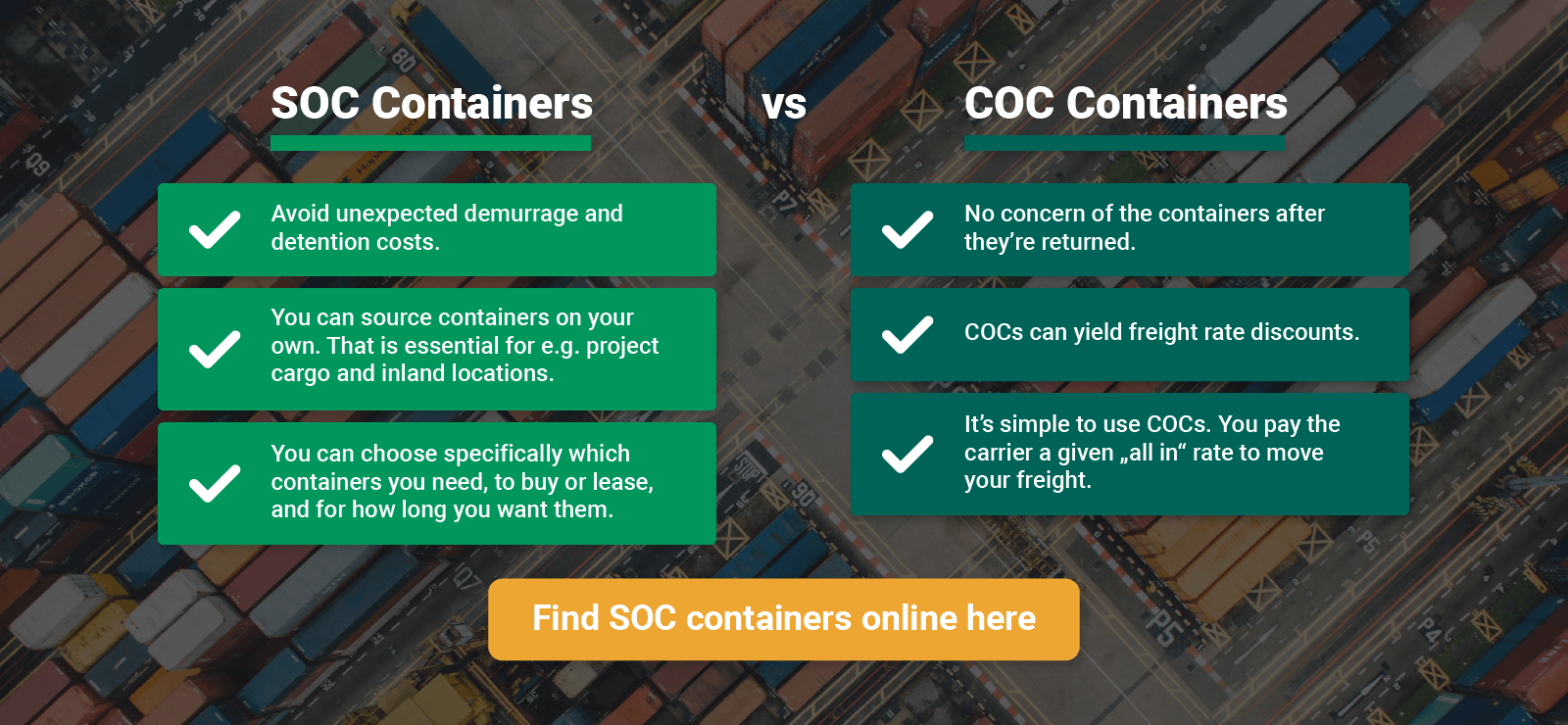
So you’ve opted for SOC containers for your shipping needs. Great! Now what about getting them onto a carrier? We’ll get to this in the next section.
Ocean Freight Marketplace: Find slots on vessels for SOC container shipments
Despite the overwhelming benefits of SOCs, getting slots for them can be tricky. Not to mention how difficult it can be to access shipping schedules when you need them. Then there’s always the worry about securing slots and waiting ages for confirmation.
Luckily, we’ve got the solution to your problems. An Ocean Freight Marketplace, allows you to access shipping schedules, compare vessel slots to find the best deals, and make secure payments, all in one place.
Once you’re a member of Container xChange, you’ll have access to this marketplace at no extra cost. So let’s check out some of the amazing benefits:
Book vessel slots for SOCs and access schedules easily
Tired of the hassle of comparing slot prices on multiple platforms, and trying to access schedules? Say goodbye to frustration and stress for good! On the Ocean Freight Marketplace, you can compare vessel slots for SOCs easily. You’ll also have instant access to schedules around the world so that you can book the best deals possible in no time at all.
Get instant quotes
On our Ocean Freight Marketplace, get freight quotes and pricing breakdowns upfront, so that you can make decisions fast. You’ll also get booking confirmation within 24 hours or less.
Safe and secure payments
At last, invoice pile-ups and payment issues can be a thing of the past. With the digital Container xChange wallet, you can rest assured all payments are safe, secure, and efficient. You’ll also have all of your transactions with different partners in one convenient place. And best of all, receive only one invoice each month. Simplicity at its best.
Compare vessel slots, get booking confirmation within just 24 hours, and make safe and secure payments on Container xChange’s Ocean Freight Marketplace. Click below to find out how you can become a member, and start reaping the benefits in no time at all.
Find the best freight rate for SOC container shipment on xChange
Container xChange is a neutral marketplace for leasing and buying shipping containers of all kinds. We’ve got 10,000+ quality SOCs just waiting for you. You can get boxes in over 2,500 unique locations worldwide.
We offer end-to-end logistics solutions and services. From searching for containers, comparing prices, and negotiating deals, to payments, invoices, and tracking, we’ve got it all, in one convenient place.
All of our members are vetted and pre-approved, so you can rest easy they’re trustworthy and reliable to work with. Once you’re a member, you’ll be able to work with the big names in the industry right away. This includes Kuehne + Nagel, Seaco Global, and Conway, to name just a few.
Payments are also 100% secure with our xChange wallet, and you’ll receive just one monthly invoice. It’s so simple!
Once you’ve secured your quality SOCs on our platform, it’s time to head on over to our Ocean Freight Marketplace, to find that perfect slot for your box, at a great price. Luckily, on our platform, you’ll get complete price transparency on freight rates and container prices, so you can make the best decisions for your business.
Ready to book vessel slots easily, get great deals on SOCs, and transact worry-free? Then it’s time to join Container xChange! Click below to get started today, by signing up for a demo of our platform. Simplifying your logistics is just a few clicks away.
What is container shipping?
Container shipping is the transport of cargo inside containers. Containers may travel on trucks, trains and ships to arrive at the destination port. A container used for shipping is made out of metal, and is strong and sturdy. Shipping containers are designed to carry heavy loads and withstand extreme weather conditions.
How much does it cost to ship a container?
The cost of shipping cargo depends on the stretch, as well as the size of the container and weight of the cargo. To lease a 20ft box from Ningbo to Liverpool will cost you approximately US $ 245, from Qingdao to New York you’ll shell out around US $ 600, and from Shanghai to Houston, you’ll pay around US $ 800.
What are the different container types?
There are many different container types, including standard dry containers, refrigerated containers, open tops, flat racks, pallet-wides and double doors. Each container type is designed for ease of use, as well as to carry specific types of cargo.



